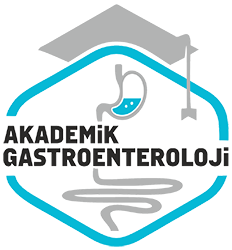Nonsirotik portal hipertansiyonlu hastalarda hepatoportal ven trombozu ile malignitelerin birlikteligi
Coincidence of hepatoportal vein thrombosis and malignity in patients with noncirrhotic portal hypertension
- Ana Sayfa
- Sayılar
- Nonsirotik portal hipertansiyonlu hastalarda hepatoportal ven trombozu ile malignitelerin birlikteligi...
Özet
Giriş ve amaç: Maligniteler metastaz, tromboz, viskozite degisıklıkleri ve vaskülit gibi nedenlerle hepatoportal venöz (portal ven ile sag, sol ve orta hepatik venler) sistemi etkileyerek nonsirotik portal hipertansiyon sebebi olabilirler. Bu çalışmanın amacı nonsirotik portal hipertansiyonlu hastalarda hepatoportal ven trombozlariyla malignitelerin birlikteligini değerlendirmektir. Gereç ve yöntem: Klinigimize 1995-2000 yıllari arasi nda basvuran nonsirotik portal hipertansiyon vakalari arasından malignite ve hepatoportal ven trombozlu hastalar retrospektif yolla değerlendirilmıştır. Bulgular: Nonsirotik portal hipertansiyonlu 28 hastanın 36%’si E [n:10, mean: 46.8, median:37, range:14-76], %64’ü K [n:18, mean:36.8, median:33, range:20-71]. Hastaların 57%’sinde [n:16, 8 E (mean:37, medium: 48, range:23-65), 8 K (mean:31, medium:35, range: 23-65)] hepatoportal ven trombozu vardı. Trombozlarin 1/3’ü hepatik, 2/3’ü portal venlerde lokalizeydi. Trombozlarin etiolojisinde: 9 hastada (56,25%) malignite [2 hepatoma, 1 kronik myeloid lösemi, 1 kolanjiokarsinoma, 1 Wilms tümörü, 1 prostat kanseri, 1 pankreas kanseri, 1 nöroendokrin tümör, 1 jinekolojik malignite], 3 hastada (18,75%) düşük protein S, C ve antitrombin-III seviyeleri, 1 hastada (6,25%) Polistemia Vera’ya bagli hiperviskosite sendromu ve 1 hastada (6,25%) pankreatitis varken 2 hastada (12,5%) etioloji saptanamadi. Sonuç: Hepatoportal ven trombozu olan nonsirotik portal hipertansiyonlu hastalarda malignite etioloji olasiligi yüksektir ve bu nedenle mutlaka aranilmalidir.
Abstract
Background and aim: Malignancies can cause noncirrhotic portal hypertension by affecting the hepatoportal vascular (right, left and middle hepatic veins and portal vein) system with metastasis, thrombosis, viscosity changes and vasculitis. The aim of this study was to assess the coincidence of hepatoportal vein thrombosis and malignancies in patients with noncirrhotic portal hypertension. Material and methods: Patients admitted to our clinic between 1995-2000 with noncirrhotic portal hypertension who had malignancy and hepatoportal vein thrombosis were assessed retrospectively. Results: Sixty-four percent (n:28) of patients with noncirrhotic portal hypertension were K [n:18, mean:36.8, median:33, range:20-71], 36% were E [n:10, mean:46.8, median:37, range:14-76]. Fifty-seven percent of noncirrhotic portal hypertension patients had hepatoportal vein thrombosis [n:16, 8 E (mean:37, medium: 48, range:23-65), 8 K (mean:31, medium:35, range:23-65)]. Onethird of thromboses were located in hepatic vein, two-thirds were located in portal vein. Among the etiologies of thromboses were: 9 patients (56.25%) with malignancies [2 hepatomas, 1 chronic myeloid leukemia, 1 Wilms tumor, 1 cholangiocarcinoma, 1 prostate cancer, 1 pancreatic cancer, 1 neuroendocrine tumor, 1 gynecologic malignancy]; 3 patients (18.75%) with low levels of protein S, C and antithrombin-III, 1 patient (6.25%) with hyperviscosity syndrome of polycythemia vera, 1 patient (6.25%) with pancreatitis and 2 patients (12.5%) with no etiology. Conclusion: Malignancy probability is quite high in patients with hepatoportal vein thrombosis and noncirrhotic portal hypertension and thus should be investigated.



